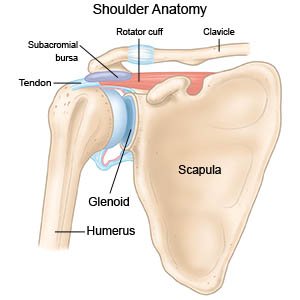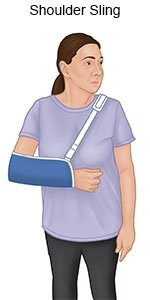Shoulder Sprain
Medically reviewed by Drugs.com. Last updated on May 6, 2024.
What is a shoulder sprain?
A shoulder sprain happens when a ligament in your shoulder is stretched or torn. Ligaments are the tough tissues that connect bones. Ligaments allow you to lift, lower, and rotate your arm.
 |
What are the signs and symptoms of a shoulder sprain?
- Bruising or changes in skin color
- Pain and stiffness, especially with movement
- Swelling and tenderness
How is a shoulder sprain diagnosed?
Your healthcare provider will ask you about your injury and examine you. Tell him or her if you heard a snap or pop when you were injured. Your healthcare provider will check the movement and strength of your joint. You may be asked to move the joint yourself. You may also need any of the following:
- An x-ray, CT scan, or MRI may show the sprain or other damage. You may be given contrast liquid to help your injury show up better in the pictures. Tell the healthcare provider if you have ever had an allergic reaction to contrast liquid. Do not enter the MRI room with anything metal. Metal can cause serious injury. Tell the healthcare provider if you have any metal in or on your body.
- Arthroscopy is a procedure to look inside your joint. Your healthcare provider makes a small incision in your joint and inserts a scope through it. The scope is a long tube with a magnifying glass, a camera, and a light on the end.
How is a shoulder sprain treated?
Treatment depends on how severe your injury is and when the injury occurred. You may need any of the following:
- A sling may be needed. A sling will limit movement of your arm and protect your shoulder joint.

- Acetaminophen decreases pain and fever. It is available without a doctor's order. Ask how much to take and how often to take it. Follow directions. Read the labels of all other medicines you are using to see if they also contain acetaminophen, or ask your doctor or pharmacist. Acetaminophen can cause liver damage if not taken correctly.
- NSAIDs , such as ibuprofen, help decrease swelling, pain, and fever. This medicine is available with or without a doctor's order. NSAIDs can cause stomach bleeding or kidney problems in certain people. If you take blood thinner medicine, always ask your healthcare provider if NSAIDs are safe for you. Always read the medicine label and follow directions.
- Prescription pain medicine may be given. Ask your healthcare provider how to take this medicine safely. Some prescription pain medicines contain acetaminophen. Do not take other medicines that contain acetaminophen without talking to your healthcare provider. Too much acetaminophen may cause liver damage. Prescription pain medicine may cause constipation. Ask your healthcare provider how to prevent or treat constipation.
- Physical therapy may be recommended by your healthcare provider. A physical therapist teaches you exercises to help improve movement and strength, and to decrease pain.
- Surgery may be needed to repair or replace a torn ligament if your sprain does not heal with other treatments.
How can I manage a shoulder sprain?
- Rest your shoulder so it can heal. Avoid moving your shoulder as your injury heals. This will help decrease the risk of more damage to your shoulder.
- Apply ice on your shoulder for 20 to 30 minutes every 2 hours or as directed. Use an ice pack, or put crushed ice in a plastic bag. Cover it with a towel before you apply it to your shoulder. Ice helps prevent tissue damage and decreases swelling and pain.
- Compress your shoulder as directed. Compression provides support and helps decrease swelling and movement so your shoulder can heal.
How can I help prevent a shoulder sprain?
- Do not exercise when you are tired or in pain. Warm up and stretch before you exercise.
- Wear equipment to protect yourself when you play sports.
- Wear shoes that fit well and run on flat surfaces to prevent falls.
When should I seek immediate care?
- You feel severe pain in your shoulder when you move it, or it is touched.
- Your skin feels cold or clammy.
- You have numbness, tingling, or a feeling of pins and needles in your shoulder.
- The skin on your injured shoulder looks blue or pale.
When should I call my doctor?
- You have new or increased swelling and pain in your shoulder.
- You have new or increased stiffness when you move your injured shoulder.
- Your symptoms do not improve within 5 to 7 days.
- You have questions or concerns about your condition or care.
Care Agreement
You have the right to help plan your care. Learn about your health condition and how it may be treated. Discuss treatment options with your healthcare providers to decide what care you want to receive. You always have the right to refuse treatment. The above information is an educational aid only. It is not intended as medical advice for individual conditions or treatments. Talk to your doctor, nurse or pharmacist before following any medical regimen to see if it is safe and effective for you.© Copyright Merative 2024 Information is for End User's use only and may not be sold, redistributed or otherwise used for commercial purposes.
Learn more about Shoulder Sprain
Care guides
Further information
Always consult your healthcare provider to ensure the information displayed on this page applies to your personal circumstances.
